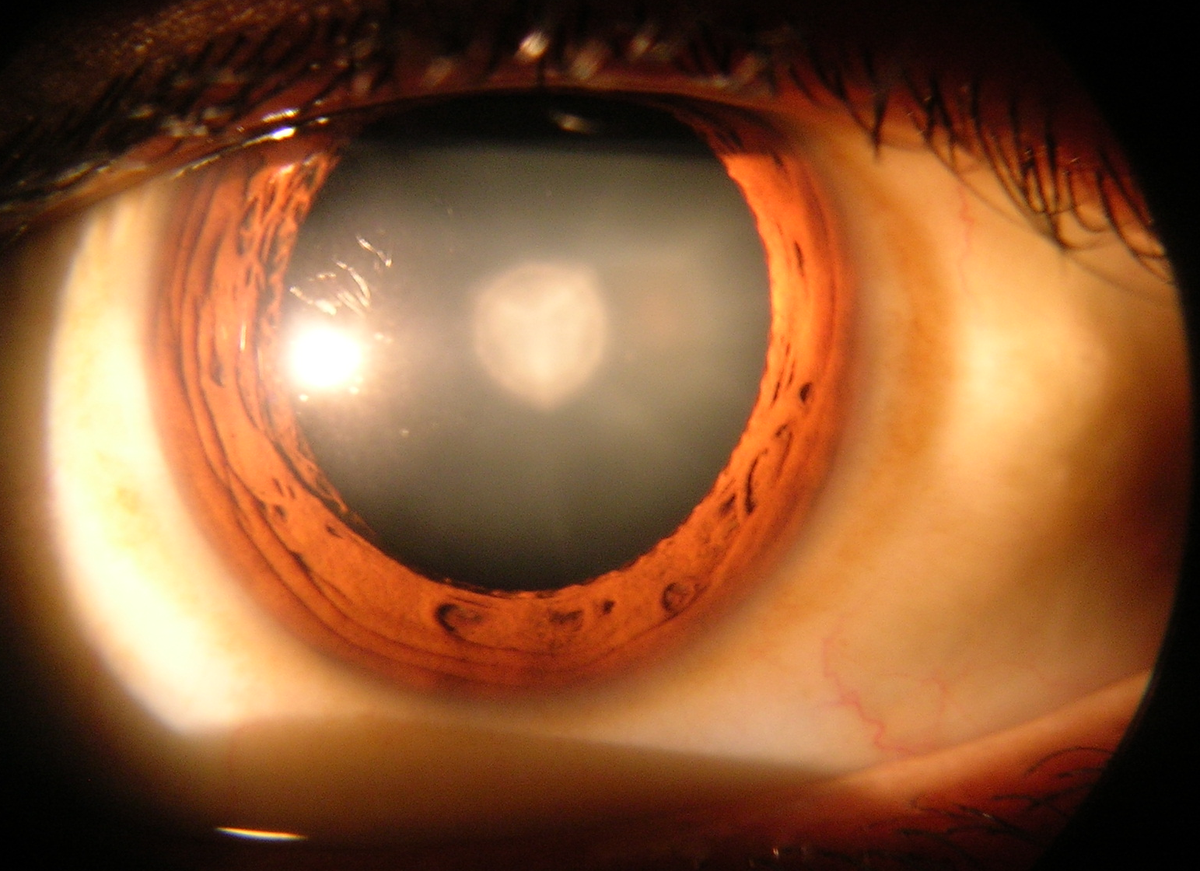Cataract
Kontributor Utama : Dr. Sharita R. Siregar, SpM(K), DR. Dr. Johan A. Hutauruk, SpM(K)
Untuk melihat artikel ini dalam kondisi terupdate, silakan menuju halaman ini.
| Cataract | |
|---|---|

Magnified view of a cataract seen on examination with a slit lamp
|
|
|
Faded colors, blurry vision, halos around light, trouble with bright lights, trouble seeing at night |
|
|
Usual onset |
Gradual |
|
Causes |
Aging, trauma, radiation exposure, following eye surgery, genetic |
A cataract is a cloudy area in the lens of the eye that leads to a decrease in vision.[1][2] Cataracts often develop slowly and can affect one or both eyes.[1] Symptoms may include faded colors, blurry or double vision, halos around light, trouble with bright lights, and trouble seeing at night.[1] This may result in trouble driving, reading, or recognizing faces.[3] Poor vision caused by cataracts may also result in an increased risk of falling and depression.[4] Cataracts cause half of all cases of blindness and 33% of visual impairment worldwide.[5][6]
Cataracts are most commonly due to aging but may also occur due to trauma or radiation exposure, be present from birth, or occur following eye surgery for other problems.[1][7] Risk factors include diabetes, longstanding use of corticosteroid medication, smoking tobacco, prolonged exposure to sunlight, and alcohol.[1] The underlying mechanism involves accumulation of clumps of protein or yellow-brown pigment in the lens that reduces transmission of light to the retina at the back of the eye.[1] Diagnosis is by an eye examination.[1]
Prevention includes wearing sunglasses and a wide brimmed hat, eating leafy vegetables and fruits, and avoiding smoking.[1][8] Early on the symptoms may be improved with glasses.[1] If this does not help, surgery to remove the cloudy lens and replace it with an artificial lens is the only effective treatment.[1] Cataract surgery is not readily available in many countries, and surgery is needed only if the cataracts are causing problems and generally results in an improved quality of life.[1][9][7][10]
About 20 million people worldwide are blind due to cataracts.[7] It is the cause of approximately 5% of blindness in the United States and nearly 60% of blindness in parts of Africa and South America.[10] Blindness from cataracts occurs in about 10 to 40 per 100,000 children in the developing world, and 1 to 4 per 100,000 children in the developed world.[2] Cataracts become more common with age.[1] In the United States, cataracts occur in 68% of those over the age of 80 years.[11] Additionally they are more common in women, and less common in Hispanic and Black people.[11]
Signs and symptoms
Causes
Diagnosis
References
- "Facts About Cataract". September 2009. Archived from the original on 24 May 2015. Retrieved 24 May 2015.
- Pandey SK (2005). Pediatric cataract surgery techniques, complications, and management. Philadelphia: Lippincott Williams & Wilkins. p. 20. ISBN 978-0781743075. Archived from the original on 2015-05-24.
- Allen D, Vasavada A (July 2006). "Cataract and surgery for cataract". BMJ. 333 (7559): 128–132. doi:10.1136/bmj.333.7559.128. PMC 1502210. PMID 16840470.
- Gimbel HV, Dardzhikova AA (January 2011). "Consequences of waiting for cataract surgery". Current Opinion in Ophthalmology. 22 (1): 28–30. doi:10.1097/icu.0b013e328341425d. PMID 21076306. S2CID 205670956.
- "Visual impairment and blindness Fact Sheet N°282". August 2014. Archived from the original on 12 May 2015. Retrieved 23 May 201
- Global Data on Visual Impairments 2010 (PDF). WHO. 2012. p. 6. Archived (PDF) from the original on 2015-03-31.
- "Priority eye diseases". Archived from the original on 24 May 2015. Retrieved 24 May 2015.
- "Recognizing Cataracts". NIH News in Health. 2017-05-30. Retrieved 2020-02-02. Try wearing sunglasses or a hat with a brim. Researchers also believe that good nutrition can help reduce the risk of age-related cataract. They recommend eating plenty of green leafy vegetables, fruits, nuts and other healthy foods.
- Lamoureux EL, Fenwick E, Pesudovs K, Tan D (January 2011). "The impact of cataract surgery on quality of life". Current Opinion in Ophthalmology. 22 (1): 19–27. doi:10.1097/icu.0b013e3283414284. PMID 21088580. S2CID 22760161.
- Rao GN, Khanna R, Payal A (January 2011). "The global burden of cataract". Current Opinion in Ophthalmology. 22 (1): 4–9. doi:10.1097/icu.0b013e3283414fc8. PMID 21107260. S2CID 205670997.
- "Cataract Data and Statistics | National Eye Institute". www.nei.nih.gov. Retrieved 2019-11-18.
- "Posterior Supcapsular Cataract". Digital Reference of Ophthalmology. Edward S. Harkness Eye Institute, Department of Ophthalmology of Columbia University. 2003. Archived from the original on 27 March 2013. Retrieved 2 April 2013.
- Mohammadpour M, Shaabani A, Sahraian A, Momenaei B, Tayebi F, Bayat R, Mirshahi R (June 2019). "Updates on managements of pediatric cataract". Journal of Current Ophthalmology. 31 (2): 118–126. doi:10.1016/j.joco.2018.11.005. PMC 6611931. PMID 31317088.
Tag: vision cataract mata blindness ophthalmology